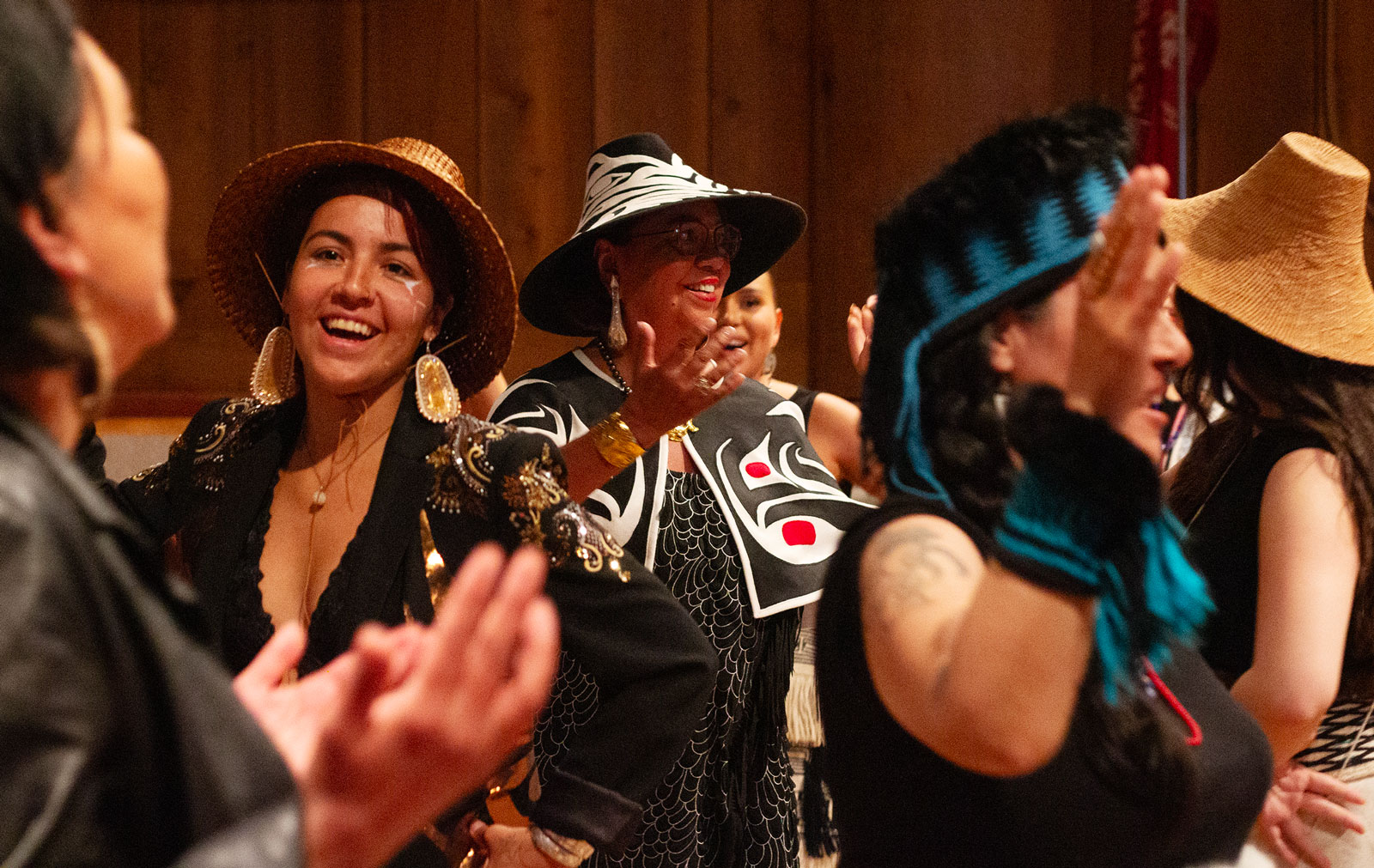At the launch of a runway-style exhibit showcasing her 40-year career in Haida art and high fashion, the crowd learned a Dorothy Grant dress can get you swept off your feet.
Kwiaahwah Jones, Dorothy Grant’s long-time assistant, told the story of Katherine Eldemar, a Tlingit-Filipina lawyer and judge who loves to wear Grant’s iconic Eagle Bolero jacket and circle dress — even from the court bench.
A hit from the 1989 Feastwear line, the debut collection Dorothy Grant launched fresh out of fashion design school in Vancouver, the striking red and black jacket features Haida formline while the matching circle dress has Spanish flair.
One day, Eldemar was walking through an airport in the Eagle Bolero ensemble when suddenly a man ran up, spun her around and dipped her.
“I’m so sorry — I just had to dance with that jacket,” he said, and walked away.
Jones told the story surrounded by a Haida Gwaii audience dressed to the nines at the July 6 opening of Dorothy Grant — Raven Comes Full Circle at the Haida Gwaii Museum.
The exhibit will be on display here until Dec. 21. It pairs with a new book, Dorothy Grant: An Endless Thread, that will be published in October. Blending fashion look-book, memoir, and cultural history, it includes writing by Grant; museologist Sdahl Ḵ’awaas, Lucy Belḻ; curators India Rael Young and Taa.uu ‘Yuuwans, Nika Collison; and Kwiaahwah Jones.

“This exhibition is life-changing for me,” Grant said at the museum launch, noting her pride that it was entirely curated and designed by Haida staff and is world-class.
“It could go to any museum in the world, and it would teach people about our culture and art,” she said.
Born in Hydaburg, Alaska, with family in Old Massett and adopted family in Skidegate, Dorothy Grant said her life’s mission has been to make beautiful clothes that uplift people’s spirits.
A seamstress since she was 13, Grant began her career by hand-sewing ceremonial button robes. She received “indelible” lessons in the patient art of spruce-root weaving from Haida master weaver Florence Davidson in Old Massett.
Among her early pieces is a Raven Wing ceremonial dress in split deerskin that was inspired by a Raven carving on an Old Massett headstone. Making it, she writes, was a “breathe deeply” kind of job.
Grant said she was first encouraged to combine Haida formline with modern, structured fashion designs by a conversation she had in 1983 with the renowned Haida artist Iljuwas, Bill Reid.
“Nobody was doing anything like this at the time,” she said.
“He said I had better do it now, before Paris designers get a hold of our art and do a bad job.”
When she and Reid began hand-painting Haida designs onto cotton-canvas vests, Grant said it was the first fashion design either of them had ever tried, but “our people have been in fashion design for millennia.”
The success of Feastwear set Grant on a high-fashion career that has included runway shows from Paris to Tokyo. Among her signature pieces is a blue and white deerskin wedding dress and headdress called “Raven Takes the World.” Dedicated to her mother, Eleanor Morrison Grant Eikemo, it is now on display at the Haida Gwaii Museum, on loan from its home at the Smithsonian National Museum of the American Indian.
Calling her the “matriarch of Indigenous fashion,” Nika Collison, executive director and curator of the Haida Gwaii Museum, spoke of the ripple effect Grant’s work has had in the fashion world and on young Indigenous designers. Today, she noted, there are Indigenous Fashion Weeks in Santa Fe, New York, Vancouver, Toronto and Paris.
Even with all her success, Grant has had to work hard to remain relevant in the notoriously fickle fashion business. She has opened and closed retail stores, moved to online sales, changed production methods, and learned to thrive in the online influencer age.
But what Jones and others say has never changed about Dorothy Grant’s work is the integrity of its Haida designs.
“Nobody arrives at success by themselves,” said Grant. In her long career, she said she has always been supported by a circle of Haida artists, jewelers, seamstresses, models, and mentors.
“To my art collaborators, I am proud to say I stayed true to the Haida formlines.”
